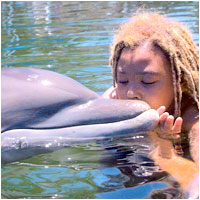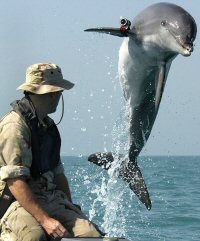Bottlenose Dolphins
The bottlenose dolphin is perhaps one of the most well known cetaceans, because of its widespread
use in marine parks and research facilities. The bottlenose dolphin may be best known as
"Flipper" (as seen in the television series). This is the dolphin most
frequently seen along the shores of the United States. This species is very flexible in its
behavior.
Anatomy
The bottlenose dolphin is highly adapted to an aquatic environment and everything about its long,
sleek, muscular body is suited for an active life in water.

Here’s a field guide to a few of its more notable external physical features.
- Melon: The bulbous portion of the dolphin's head just in front of the blowhole.
The melon is full of complex fatty connective tissue. It directs sounds, used for echolocation,
produced in the nasal sac.
- Blowhole: The blowhole is the opening, located just behind the melon, through which the animal
breathes air. The blowhole is homologous to (of similar origin to) the nostril of other mammals.
When bottlenose dolphins surface, they exhale, or blow, old air and inhale fresh air through the blowhole
before re-submerging. A way to tell the difference between dolphins and whales is the number of blowholes
they have: Whales have two and dolphins have only one.
- Dorsal Fin: The fin located on the back, or dorsal part, of the dolphin. The dorsal fin helps the
animal keep steady in the water by reducing roll. Its size, shape, and contours are unique to each individual
dolphin. Dolphin researchers use these individually unique dorsal fin characteristics to identify individuals.
- Flukes: The lobes of the tail of the dolphin. When moved up and down by the trunk muscles, the
flukes displace water and propel the dolphin forward through the water. The flukes contain no muscle but
possess many subcutaneous blood vessels that make them work like radiators that release heat generated by
physical effort.
- Flippers: The front, side appendages of the dolphin. The bottlenose dolphin’s fins are used for
steering and not propulsion.
Behavior
 Tuna are among the bottlenose dolphin's preferred foods.
Tuna are among the bottlenose dolphin's preferred foods.
- Dolphins in a pod appear to establish strong social bonds.
- Each dolphin appears to have its own distinctive whistle used to communicate information on
its identity, location, and condition to other dolphins. Dolphins also use click-like pulses
produced by nasal sacs in the forehead for echolocation.
- They generally consume approximately 6-7 kg of seafood (squid, shrimp, eel, and a wide
variety of fishes) daily.

Groups of a dozen or so Bottlenose have been known to join together to form an
even larger herd and swim alongside of the Atlantic Pilot Whale in the Atlantic.
Interaction with humans
When interacting with dolphins, you must be very careful. While most
dolphins and people can swim perfectly happily together, dolphins are wild
creatures and cannot easily communicate pain or discomfort to humans. It is always
important to refrain from touching near a dolphin's eye or blowhole, and to avoid
too much body-to-body contact to protect the health of the dolphin.
- Bottlenose dolphins often perform in dolphin shows. Some animal welfare groups oppose
this practice due to the thought the dolphins don't receive adequate care. However, other
support groups advocate the practice because the dolphin are properly cared for and the
dolphin enjoy human interaction.
- Therapies for handicapped children involve interaction with bottlenose dolphin. These
therapies have proven to be very successful.
- The United States and Russian military train bottlenose dolphin for wartime tasks such
as locating sea mines and detecting enemy divers.
 Children respond more positively to dolphins than to other animals. When handicapped children play
with dolphins they relax and concentrate far more than in conventional situations.
Children respond more positively to dolphins than to other animals. When handicapped children play
with dolphins they relax and concentrate far more than in conventional situations.
|
 A bottlenose dolphin leaps out of the water while training near USS Gunston Hall in the Arabian
Gulf during Operation Iraqi Freedom. It is wearing an acoustic tracking device on its fin.
A bottlenose dolphin leaps out of the water while training near USS Gunston Hall in the Arabian
Gulf during Operation Iraqi Freedom. It is wearing an acoustic tracking device on its fin.
|
References: Smithsonian National Zoological Park, Wikipedia, Defenders of Wildlife,
American Cetacean Society, Kid's National Geographic, MarineBio, Enchanted Learning, & NDIA San Diego
Back to Assignment 4 Challenge
Back to Studies Index




 Children respond more positively to dolphins than to other animals. When handicapped children play
with dolphins they relax and concentrate far more than in conventional situations.
Children respond more positively to dolphins than to other animals. When handicapped children play
with dolphins they relax and concentrate far more than in conventional situations.
 A bottlenose dolphin leaps out of the water while training near USS Gunston Hall in the Arabian
Gulf during Operation Iraqi Freedom. It is wearing an acoustic tracking device on its fin.
A bottlenose dolphin leaps out of the water while training near USS Gunston Hall in the Arabian
Gulf during Operation Iraqi Freedom. It is wearing an acoustic tracking device on its fin.
